Hamamatsucho
2025.06.01
[Hamamatsucho] Create Your Own Japanese Hanko Stamp at Hanko Land Tokyo

Looking for a truly unique souvenir from Japan? Instead of grabbing a keychain or T-shirt, why not create your very own hanko stamp—a traditional Japanese name seal that’s still used for everything from signing documents to adding a personal touch to letters and art. Just a 10-minute train ride from HOTEL TAVINOS Hamamatsucho, you’ll find Hanko Land Tokyo, a tourist-friendly hanko specialty shop where you can customize your stamp with your name in kanji and the alphabet. It’s a small item packed with cultural meaning—and one of the most memorable keepsakes you can take home!
Table of Contents
What is a Hanko Stamp? A Historical Look at Japan’s Personal Seals
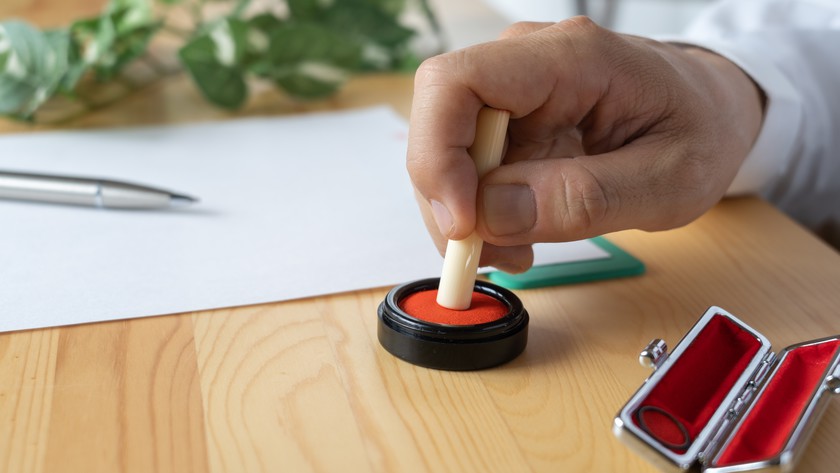 Hanko stamps, or personal seals, have been an essential part of Japanese culture and daily life for millennia. Their use in Japan dates back to AD 57, when the Chinese Emperor bestowed a golden seal to a Japanese ruler—considered the oldest known instance of a hanko in Japan. It is said that hanko began to be used more widely around AD 701 after national seal systems were established . This tradition has remarkably endured the test of time—hanko are still widely used as a substitute for a handwritten signature on documents, contracts, and various forms of identification in Japan today.
Hanko stamps, or personal seals, have been an essential part of Japanese culture and daily life for millennia. Their use in Japan dates back to AD 57, when the Chinese Emperor bestowed a golden seal to a Japanese ruler—considered the oldest known instance of a hanko in Japan. It is said that hanko began to be used more widely around AD 701 after national seal systems were established . This tradition has remarkably endured the test of time—hanko are still widely used as a substitute for a handwritten signature on documents, contracts, and various forms of identification in Japan today.Unlike Western-style handwritten signatures, a hanko serves as a standardized and legally recognized alternative that represents a person’s identity through a unique stamp impression. In recent years, many overseas visitors have started purchasing hanko as memorable souvenirs—not only for their cultural significance, but also for the personalized touch and artistry each stamp offers.
Create Your Custom Hanko Stamp at Hanko Land Tokyo
 While Japan has no shortage of places where you can have a hanko stamp custom-made, Hanko Land Tokyo in Shinagawa Ward can help you select the perfect kanji for your name and create a one-of-a-kind hanko in as little as 60 to 90 minutes. Additionally, the entire hanko ordering process can be completed in English, making it easy for international visitors.
While Japan has no shortage of places where you can have a hanko stamp custom-made, Hanko Land Tokyo in Shinagawa Ward can help you select the perfect kanji for your name and create a one-of-a-kind hanko in as little as 60 to 90 minutes. Additionally, the entire hanko ordering process can be completed in English, making it easy for international visitors.Originally established in 1921 as Bunbukudo Inbo, this hanko specialty shop—now run by third-generation owner Mr. Fumikazu Matsuzaki—has become especially popular for its unique “dual hanko” service created with international visitors in mind. Introduced in 2016, the dual hanko features a person’s name in both kanji and English letters, making it easy for non-Japanese speakers to recognize their own name on the stamp.
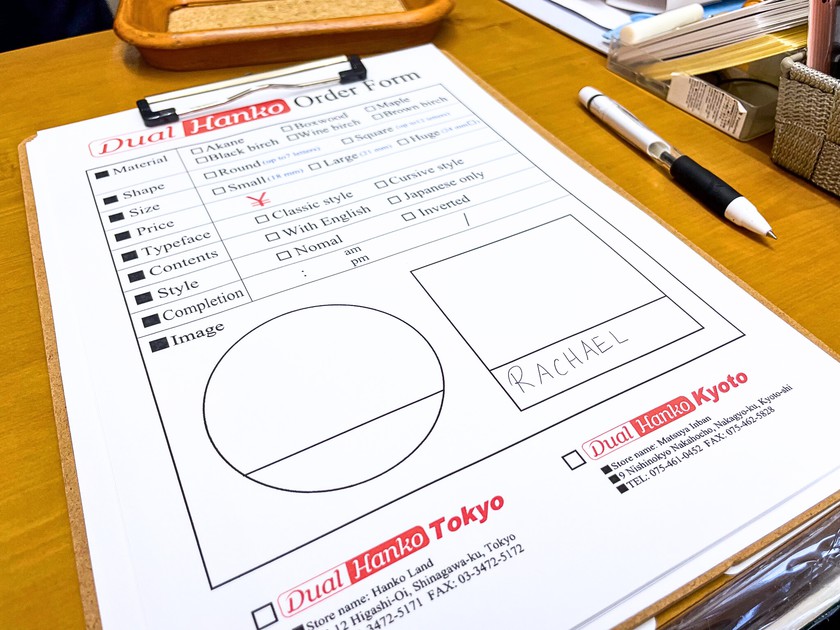
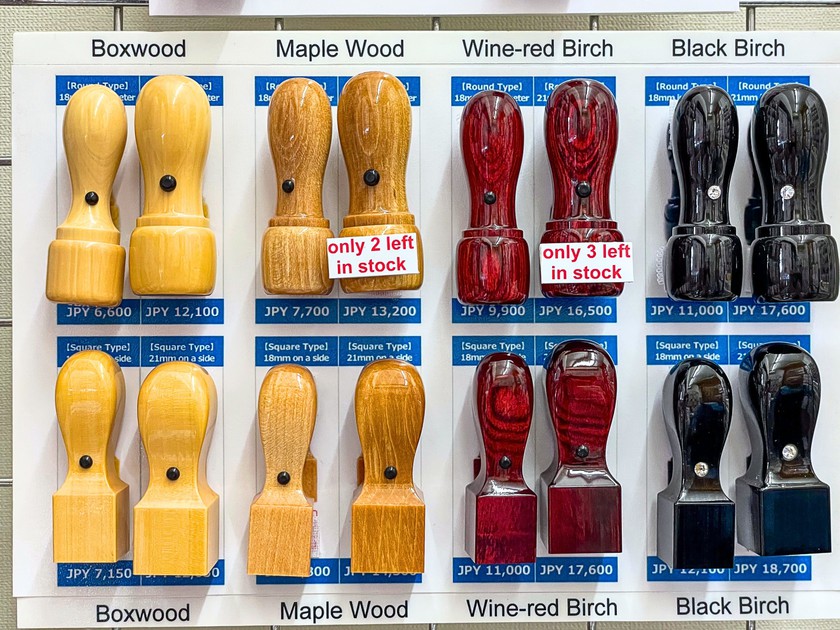 To get your own hanko, you’ll start by filling out an order form, where you can choose the material, shape, and size of your stamp. The number of letters in your name will help determine which shape is best for you—round hanko can fit up to seven English letters, while square ones can hold up to twelve. You can also pick the wood type and size that suit your style, with a variety of colors available to make your hanko uniquely yours.
To get your own hanko, you’ll start by filling out an order form, where you can choose the material, shape, and size of your stamp. The number of letters in your name will help determine which shape is best for you—round hanko can fit up to seven English letters, while square ones can hold up to twelve. You can also pick the wood type and size that suit your style, with a variety of colors available to make your hanko uniquely yours.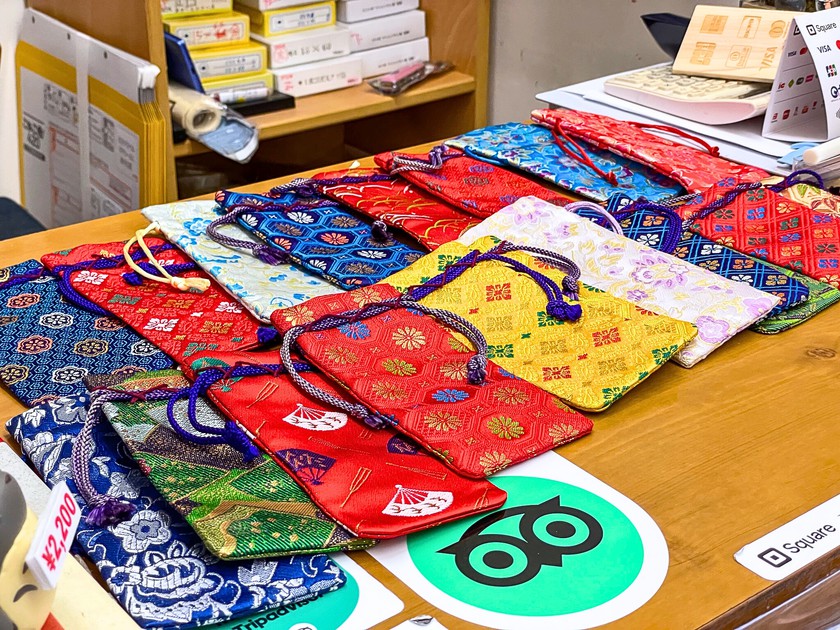 You’ll can also choose from a wide selection of brocade pouches with traditional Japanese patterns for storing your hanko when not in use.
You’ll can also choose from a wide selection of brocade pouches with traditional Japanese patterns for storing your hanko when not in use.
Choose the Kanji Character that Best Represents You
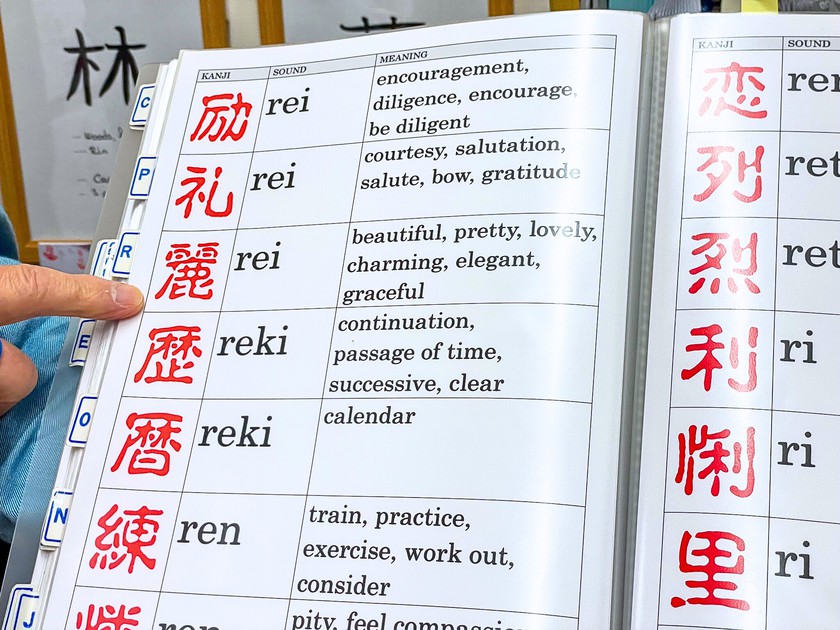 Next, you’ll get to choose which kanji character you’d like to use for your name. Mr. Matsuzaki offers a helpful look-book filled with different kanji, along with their readings and meanings. Since several kanji can share the same pronunciation, you can pick the ones whose meanings resonate with you most. While there may not always be an exact kanji match for every sound in a name, it’s usually possible to get very close. If customers want their name to appear in both kanji and the alphabet, they are simply asked to write their name in capital letters at the bottom of their chosen hanko style.
Next, you’ll get to choose which kanji character you’d like to use for your name. Mr. Matsuzaki offers a helpful look-book filled with different kanji, along with their readings and meanings. Since several kanji can share the same pronunciation, you can pick the ones whose meanings resonate with you most. While there may not always be an exact kanji match for every sound in a name, it’s usually possible to get very close. If customers want their name to appear in both kanji and the alphabet, they are simply asked to write their name in capital letters at the bottom of their chosen hanko style.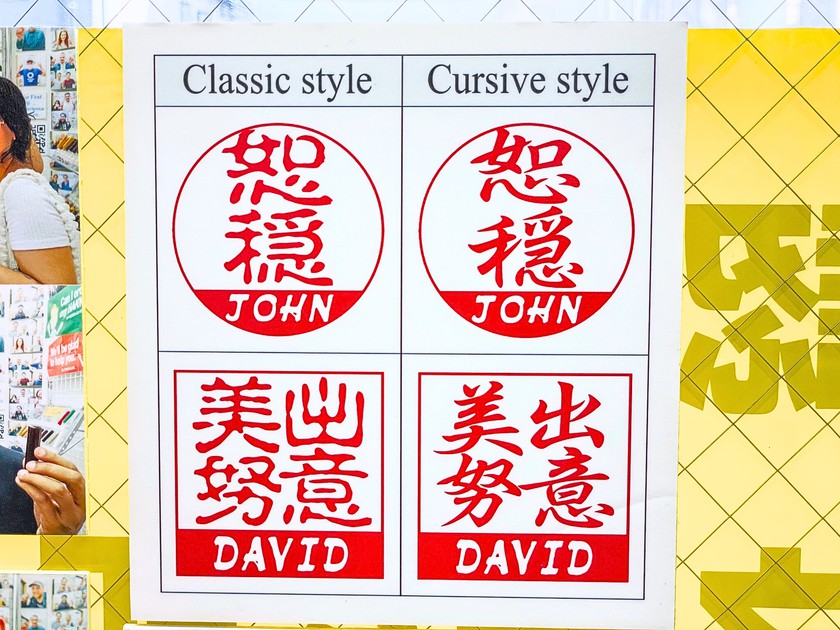
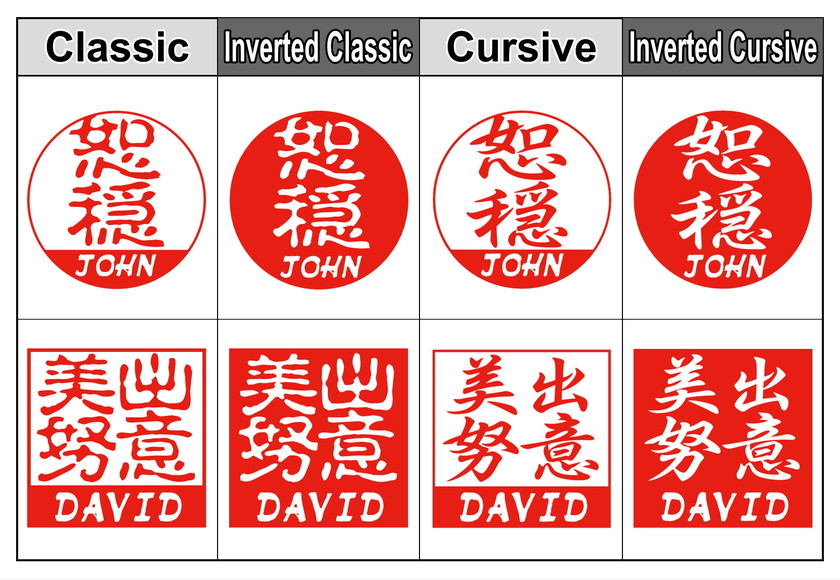 There are two typefaces available for the kanji: a classic style that has a rough, hand-carved appearance, and a smoother, more fluid cursive style. Customers can also decide whether they prefer the image inverted (characters are carved out), so the stamp prints in relief, or non-inverted (the space around the characters is carved out) for a more traditional look.
There are two typefaces available for the kanji: a classic style that has a rough, hand-carved appearance, and a smoother, more fluid cursive style. Customers can also decide whether they prefer the image inverted (characters are carved out), so the stamp prints in relief, or non-inverted (the space around the characters is carved out) for a more traditional look.
Speedy Service and Special Surprises for International Visitors
Amazingly, the creation of a personal hanko typically takes just 60 to 90 minutes, though wait times may be longer during busy periods. While reservations aren’t required, it’s a good idea to book in advance—especially for those on a tight schedule—by using the store’s visit appointment form.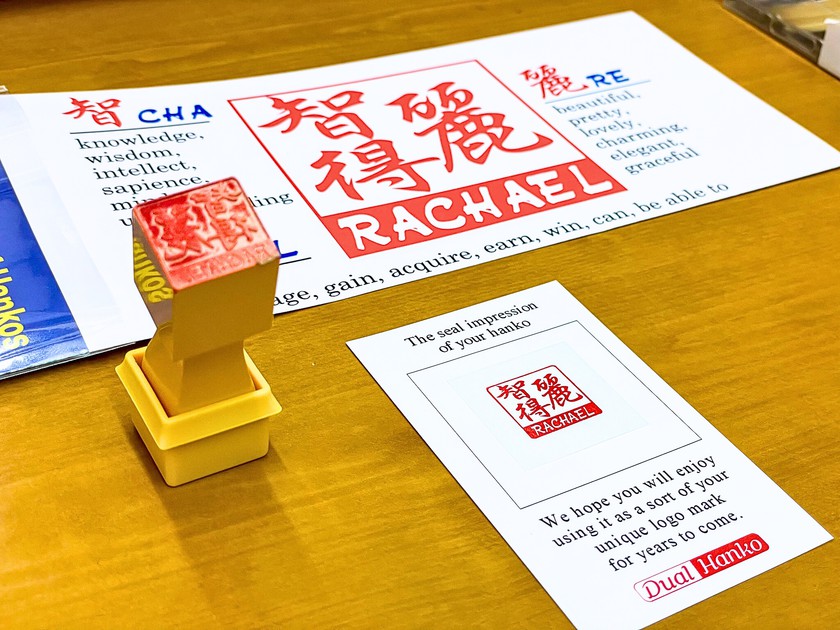 With your finished dual hanko, you’ll receive a card detailing the reading and meanings of the kanji used in your name, making it easy to remember the significance behind your personalized stamp for years to come. Additionally, guests who agree to have their photo shared on the store’s social media will receive a complimentary ink pad as a special bonus.
With your finished dual hanko, you’ll receive a card detailing the reading and meanings of the kanji used in your name, making it easy to remember the significance behind your personalized stamp for years to come. Additionally, guests who agree to have their photo shared on the store’s social media will receive a complimentary ink pad as a special bonus.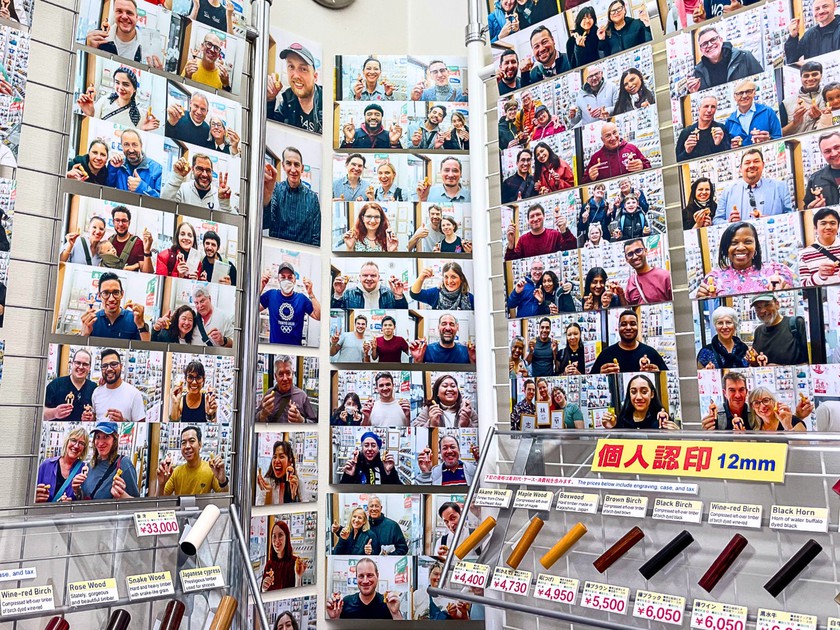 While the hanko itself makes for a memorable souvenir, meeting Mr. Matsuzaki is truly a highlight of the experience. Exceptionally friendly and fluent in English—despite never having traveled abroad—Mr. Matsuzaki has honed his language skills through conversations with international visitors. His dedication to making every customer’s visit enjoyable is evident in the many photos of smiling guests displayed throughout the shop. When it’s time to pick up your finished hanko, there are even a few fun surprises waiting for you. What kind of surprises? You’ll just have to visit and find out!
While the hanko itself makes for a memorable souvenir, meeting Mr. Matsuzaki is truly a highlight of the experience. Exceptionally friendly and fluent in English—despite never having traveled abroad—Mr. Matsuzaki has honed his language skills through conversations with international visitors. His dedication to making every customer’s visit enjoyable is evident in the many photos of smiling guests displayed throughout the shop. When it’s time to pick up your finished hanko, there are even a few fun surprises waiting for you. What kind of surprises? You’ll just have to visit and find out!
How to Get to Hanko Land Tokyo from HOTEL TAVINOS Hamamatsucho
Hanko Land Tokyo is easy to reach for guests staying at HOTEL TAVINOS Hamamatsucho. Simply hop on the JR Keihin-Tohoku Line local train for about 10 minutes and get off at Oimachi Station. From there, it’s just a five-minute walk—exit the station to the left and you’ll find the shop nearby.Hanko Land Tokyo is open on national holidays, although with shorter hours. To check the latest opening times, look for the orange banner at the top of their website before you visit.
Hanko Land Tokyo
Address: 5-7-12 Higashioi, Shinagawa-ku, Tokyo
Hours:
● Mondays to Fridays: 10:00 am – 6:00 pm
● Sundays: 10:00 am – 2:00 pm
● Business hours on national holidays would be shorter than those on weekdays
Closed: Saturdays
Access: about 3-minute walk from Oimachi Station on the JR Keihin-tohoku Line, Tokyo Waterfront Area Rapid Transit Rinkai Line or Tokyu Railways Oimachi Line
Website: https://hankoland.com/e.html
